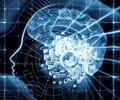Harvard University psychologists have devised a new method to study extrasensory perception, which they believe can resolve the age-old debate over its existence.
Harvard University psychologists have devised a new method to study extrasensory perception, which they believe can resolve the age-old debate over its existence.
The researchers say claim that they have obtained the strongest evidence against the existence of extrasensory perception (ESP), which includes telepathy, clairvoyance, and precognition, however they admitted that the new approach did not conclusively prove that ESP does not existThey say that they used brain scanning to test whether individuals have any such knowledge that cannot be explained through normal perceptual processing.
"If any ESP processes exist, then participants' brains should respond differently to ESP and non-ESP stimuli. Instead, results showed that participants’ brains responded identically to ESP and non-ESP stimuli, despite reacting strongly to differences in how emotional the stimuli were and showing subtle, stimulus-related effects," said Samuel Moulton, a graduate student in the department of psychology in the Faculty of Arts and Sciences at Harvard University.
Since the brain enables perception and stores information, the researchers were of the opinion that a test addressed to the organ will be a better test of ESP.
"The brain shows a suppressed response to stimuli that a person has seen before, even when those stimuli were presented subliminally, so the person wasn't consciously aware of having seen them; furthermore, it shows an enhanced response to stimuli that a person is expecting," says Moulton.
"Because knowledge and expectation bias brain activation, neuroimaging offers us a uniquely powerful test of subtle perceptual or cognitive processes," the researcher adds.
Advertisement
However, ESP stimuli were not only presented visually to the participants, but also telepathically, clairvoyantly, and precognitively.
To present stimuli clairvoyantly, the photographs were displayed on a distant computer screen.
To present stimuli precognitively, the researchers showed participants the photographs again in the future.
Moulton admitted that the new approach did not conclusively prove that ESP does not exist.
The researcher, however, said that it offered a test with fewer limitations.
"You cannot affirm the null hypothesis. But at the same time, some null results are stronger than others. This is the best evidence to date against the existence of ESP. Perhaps most important, this study offers scientists a new way to study ESP that avoids the pitfalls of past approaches," Moulton said.
The study has been reported in the Journal of Cognitive Neuroscience.
Source-ANI
LIN/P






